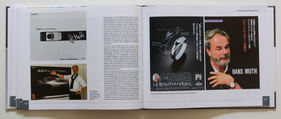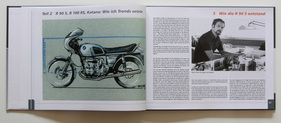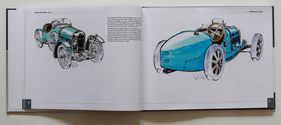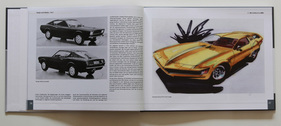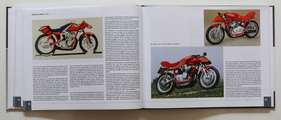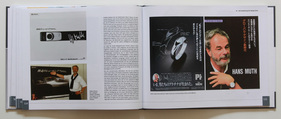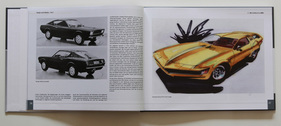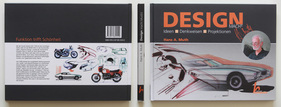The name Hans A. Muth is probably less familiar to automobile enthusiasts than to motorcycle fans. After all, his greatest creations include the BMW R 90 S and R 100 RS motorcycle models, as well as the Suzuki Katana two-wheelers. However, Muth also left his mark in the automotive sector, for example with his designs for model alternatives in Motor Revue in the fifties or with his illustrated portfolios for famous Grand Prix racing cars, which primarily showcased his drawing skills. In the sixties and early seventies, the self-confessed motorcycle fan was also employed in the automotive industry, first at Ford and later at BMW.
Various interior designs for BMW models originate from his "pen", including the cockpit of the BMW Turbo study and the 2002 Turbo.
However, motorcycles and the freedom of design associated with them always drew him back to two-wheelers; later, his work with cars, such as special models for the Suzuki Jipsy or an Electro-Urban Roadster, remained the exception.
Now Muth, born in 1935 in Rathenow, west of Berlin, has written a book about his relationship with design and his life.
Autobiography
The book is divided into four parts and begins with basic design considerations. This is followed by the years at Ford and BMW, with a focus on the BMW motorcycle years. This is followed by a look back at the work with Japan. The book concludes with around 40 pages of biographical elements, but also with glimpses of the (design) future.
The life story alone makes for fascinating reading, as it was by no means a straightforward one. Although his love of two to four-wheelers was evident from an early age, paternal ideas, a world war and other problems intervened. Nevertheless, Muth always pursued his goals in life and did not allow himself to be discouraged by setbacks.
Muth talks in great detail about his career, strokes of fate and successes, without appearing wistful or arrogant.
On the occasion of the presentation of his book, the opportunity arose for a short interview. Asked whether he never missed cars after his switch to motorcycle design, Hans A Muth replied:
"The design for the BMW car models at the time was largely handled by Paul Bracq, Manfred Renner and Mr. Hofmeister. For me, the way they went about it was boring and not progressive. Here, the motorcycle presented itself - on my own initiative - on the one hand as my passion, and on the other hand as a new beginning, as the appearance of the motorcycle had previously been determined by the BMW Motorrad developers.
The differences result from the dimensions and overall design, the close visually perceptible interplay between visible technology in its specific materials and surfaces, colors and shapes in their functional aesthetics. I was able to set trends here. Equally interesting is the difference that you sit in a car, protected in the premises and stable on four wheels, whereas on a motorcycle you physically become an integrated component, a 'Centaur' so to speak. The motorcycle is and was simply the greater challenge than the modern car, especially when you look at today's egalitarianism and the flight to SUVs and electronic gadgets."
This is a man with gasoline in his blood speaking with clear views. Muth was already known for these in the course of his career and sometimes his clear ideas helped him, sometimes they hurt him. But he always remained true to himself.
Design view
Hans A. Muth uses a considerable part of the more than 180 pages of the book to document his own design philosophy. For Muth, design is not an end in itself. Design is also more than styling. Design must bring function and form together in such a way that the result is visually convincing and at the same time can be used efficiently in the sense of the object. He demonstrates this with countless examples, some of which are his own work, but some of which were also designed by others. Muth primarily uses motorcycle examples here.
Design development
The book also tells you a lot about how design is created. Among other things, Muth mentions the "4 Cs", i.e. "creative", "conceptional", constructive" and "consequent", mentions that the "4 Cs" can also be pronounced phonetically almost like "foresee" and that if one of the four terms is not fulfilled, concepts (and their subsequent development) will prove to be inconsistent.
However, the stories in the book also show that, in addition to good craftsmanship, a certain amount of intuition is also required to be a good designer. Examples of this are the interior of the BMW Turbo Study, which was created in less than two hours, or the first steps towards the BMW 80 G/S motorcycle, a Range Rover on two wheels, which, as is well known, became an enormous commercial success. And in his book, Hans A. Muth clearly demonstrates that he had a good feeling for what would be popular.
Car stories
Although Muth was more active in motorcycle design than car design, he also left his mark on the automobile. At Ford, he was Design Executive for Advanced Exterior and Pre-Program-Interior. Among other things, he designed advanced preliminary studies for the Capri, a sporty coupé, as well as the Consul and Granada, but also the Berliner, an early electric car for urban use.
But his own automotive career is also interesting, as he reports in the interview:
"I have specific memories of each of my cars, and in retrospect, the fleet was huge. It started with the MG TF, an Alfa-Romeo 1900 with Pinin-Farina bodywork, the Fiat-Abarth 750, a right-hand drive Lancia Aurelia GT 2500, another Abarth 2000 and many more, including a Jaguar XK 150, several Ferraris, two Morgan, two Donkervoort, an AC Cobra, a Mazda Eunos, several Audi quattro and TT, as well as Volkswagen and Porsche models.
At the very beginning, however, there was a Bugatti Type 44, which I bought together with a friend for DM 3000. Unfortunately, my father put a stop to the whole thing. Something similar happened with a Ferrari 166 MM, which I discovered as a Le Mans coupé at a car dealer in Baselland. My wife intervened with the Ferrari. Car or wife? I decided in favor of my wife, to whom I have now been married for 60 years."
Some of the cars can be seen in the book and they make it clear that Muth had an eye for the unusual from the very beginning and certainly did not have average taste.
The cars were joined by countless motorcycles from a wide variety of manufacturers and with two- and four-stroke engines. Looking back, Muth says in the book (on the occasion of the purchase of the Fiat-Abarth 750 Zagato:
"As was often the case later, it was the little things that were intuitively representative of the whole visually, haptically and acoustically that led me to a spontaneous purchase decision. In this case, it was the special movement of the (rev counter) pointer and the typical engine sound that represented the character of this little coupé."
This enthusiasm for special means of transportation, which also includes bicycles, streetcars and locomotives, can be felt throughout the book and makes reading it a pleasure.
EUR 39.50 is certainly not excessive, especially as the print run is likely to be small.
Bibliographic information
- Title: Design makes courage(h): Ideas - Mindsets - Projections
- Author: H.A. Muth
- Language: German
- Publisher: Dustri-Verlag Dr. Karl Feistle GmbH & Co KG
- Edition: 1st edition October 2019
- Format: Hardcover, 29.7 cm x 22.5 cm
- Scope: 182 pages, numerous illustrations
- ISBN: ISBN 978-3-87185-555-9
- Price: EUR 39.50
- Order to buy: Directly from the publisher, online at amazon.de or in relevant bookstores















